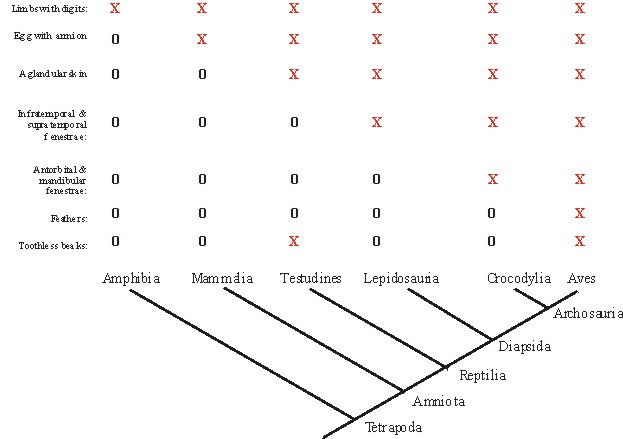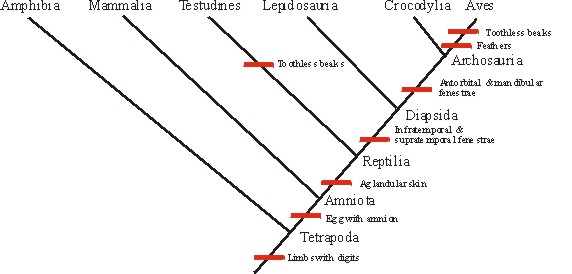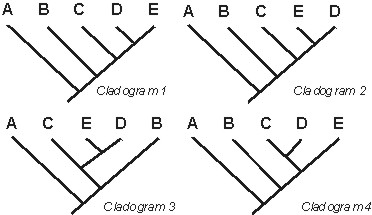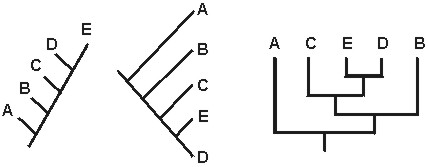GEOL 104 Dinosaurs: A Natural History
Fall Semester 2006
Systematics III: Cladistics
Cladograms represent a way of graphically portraying the evolutionary relationships of
organisms. How are these relationships discovered?
Because evolution is descent with modification, ancestral species will pass on
evolutionary novelties that they developed, as well as primitive features developed in even
earlier ancestors. Features can be morphological, behavioral, molecular (DNA), etc. (however,
for paleontological purposes morphological are best).
Anatomical (and behavioral, and genetic) features that are similar between taxa are said
to be shared characters. Three different reasons these features are shared:
- Synapomorphies (shared derived characters), representing new
specializations evolved in the concestor of the ingroup;
- Symplesiomorphies (shared primitive characters), representing common
homologies found in the groups of interest and some of their more distant relatives;
- Homoplasies, representing similarities not inherited directly from a
common ancestor but are instead convergences (evolved separately in independent lineages)
or reversals (evolved from a derived condition back to the primitive condition)
Cladograms are constructed by sorting out the simplest (most parsimonious)
arrangement of shared derived characters. For example, below is a cladogram of living terrestrial
vertebrates, and a list of characters above. In that list, a red "X" represents
the presence of that feature in the taxon, and a black "0" represents the absence
of that feature.

So, in the diagram above:
- "Limbs with digits" are present in all the terminal taxa;
- "Eggs with amniotic fluid" is absent in amphibians, but present in mammals, turtles,
lepidosaurs, crocodilians, and birds (or, in other words, is absent in Amphibia but present in Amniota);
- "Agladandular skin" is absent in amphibians and mammals, but present in reptiles;
- Etc.
Or, to put it another way:
"Limbs with digits" is a synapomorphy for Tetrapoda, but a symplesiomorphy
for all its subclades (e.g., Amphibia, Amniota, Mammalia, Reptilia, etc.)
"Eggs with amnion" is a synapomorphy for Amniota, but a symplesiomorphy for
all of its subclades (e.g., Mammalia, Reptilia, Testudines, etc.)
"Toothless beaks" is a homoplasy (i.e., a convergence) between Testudines
and Aves, as the forms intermediate between them (lepidosaurs, crocodilians) retain the
primitive condition of having teeth.
Another particular kind of character is an autapomorphy, a feature found in only
one of the terminal taxa in an analysis.
In the above cladogram, the presence of "feathers" is an autapomorphy of Aves; no
other living vertebrate has feathers. (However, WITHIN Aves, feathers would be
a symplesiomorphy).
Another, simpler way of drawing the above cladogram is to indicate the characters on the
braches where they would have originated:

In the cladogram above, the characters evolved on the branch where the red line indicate:
"Limbs with digits" evolved in the common ancestor of all tetrapods, and is a
synapomorphy for Tetrapoda;
"Eggs with amnion" evolved in the common ancestor of all amniotes, and is
a synapomorphy for Amniota;
Etc.
Note that even the synapomorphies shown here can be modified through additional evolution
at any point further up in the cladogram:
- Although some modern mammals (the monotremes: platypi and echidnas) lay shelled amniotic
eggs, most (marsupials and placentals) have internalized these tissues and so do not lay
eggs outside the body: this internalization is a synapomorphy of a group containing
marsupials and placentals, but not monotremes.
- Modern snakes lack limbs with digits: this transformation is a sort of homoplasy
(specifically, a reversal to the ancestral vertebrate condition), since ancestral snakes
and their outgroups (other lizards, archosaurs, turtles, mammals, amphibians) all have limbs
with digits
Fun with Cladograms!
In a cladogram, it is the branching relationships which are important, not the "right
to left"/"top to bottom" order. As long as two cladograms contain the same branching relationships,
and do not have any contradictory branching relationships, they are equivalent:

In the above cases,cladograms 1-3 are all equivalent: they represent the same information.
However, cladogram 4 is not equivalent to the other three:
Cladogram 4 says that C and D are more closely related (share a more recent common ancestor)
with each other than either do with E, but in the other cladograms D is more closely related
to E than to C.
The below pictures are all equivalent to cladogram 1 above, but just drawn in different ways:

In a cladogram, terminal taxa can be expanded to show the relationships within them,
and nodes can be collapsed if we aren't interested in the details within that group.
For example, if we were more interested in mammalian evolution than reptile evolution,
we can modify the tetrapod cladogram above show the following:

This cladogram was modified from the previous one by:
- Collapsing the Reptilia node
- Expanding the Mammalia node
- Rotating at the Amniota node
The cladogram is equivalent to the previous one insofar as it doesn't violate any of the
branching relationships, but it:
- Conveys more information about mammal relationships, but
- Conveys less information about reptile relationships
Another name for a monophyletic group is a clade; modern systematics is thus called
cladistics.
Diagnosis of a taxon: the list of features that are synapomorphies at that node
(or autapomorphies, if a terminal taxon).
Definition of a taxon (in cladistics): a statement of common ancestry which
describes a particular clade.
To Next Lecture.
To Previous Lecture.
To Syllabus.
Last modified: 14 July 2006






